| Article ID | Journal | Published Year | Pages | File Type |
|---|---|---|---|---|
| 10566133 | Ultrasonics Sonochemistry | 2014 | 10 Pages |
Abstract
The effect of flow in an ultrasonic reactor is an important consideration for practical applications and for the scale-up of ultrasonic processing. Previous literature on the influence of flow on sonochemical activity has reported conflicting results. Therefore, this work examined the effect of overhead stirring at four different frequencies, 40, 376, 995 and 1179Â kHz, in two different reactor configurations. Comparable power settings were utilised to elucidate the underlying mechanisms of interactions between the flow and sonochemical activity. The sonochemical activity was determined by the yield of hydrogen peroxide, measured by iodide dosimetry, and the active region was visualised with sonochemiluminescence imaging. The overhead stirring in the low frequency reactor altered the yield of hydrogen peroxide so it produced the maximum yield out of the four frequencies. The increase in hydrogen peroxide yield was attributed to a reduction in coalescence at 40Â kHz. However at the higher frequencies, coalescence was not found to be the main reason behind the observed reductions in sonochemical yield. Rather the prevention of wave propagation and the reduction of the standing wave portion of the field were considered.
Related Topics
Physical Sciences and Engineering
Chemistry
Chemistry (General)
Authors
Madeleine J. Bussemaker, Dongke Zhang,
